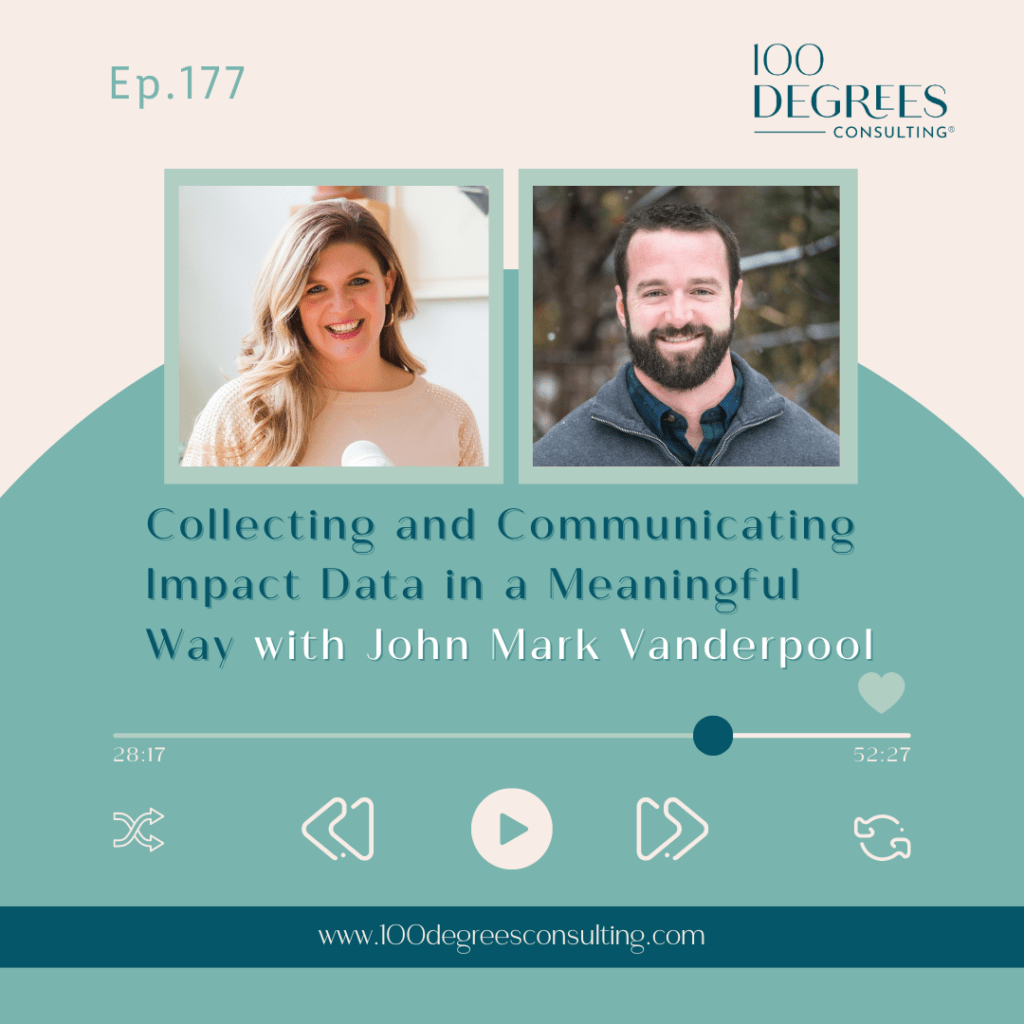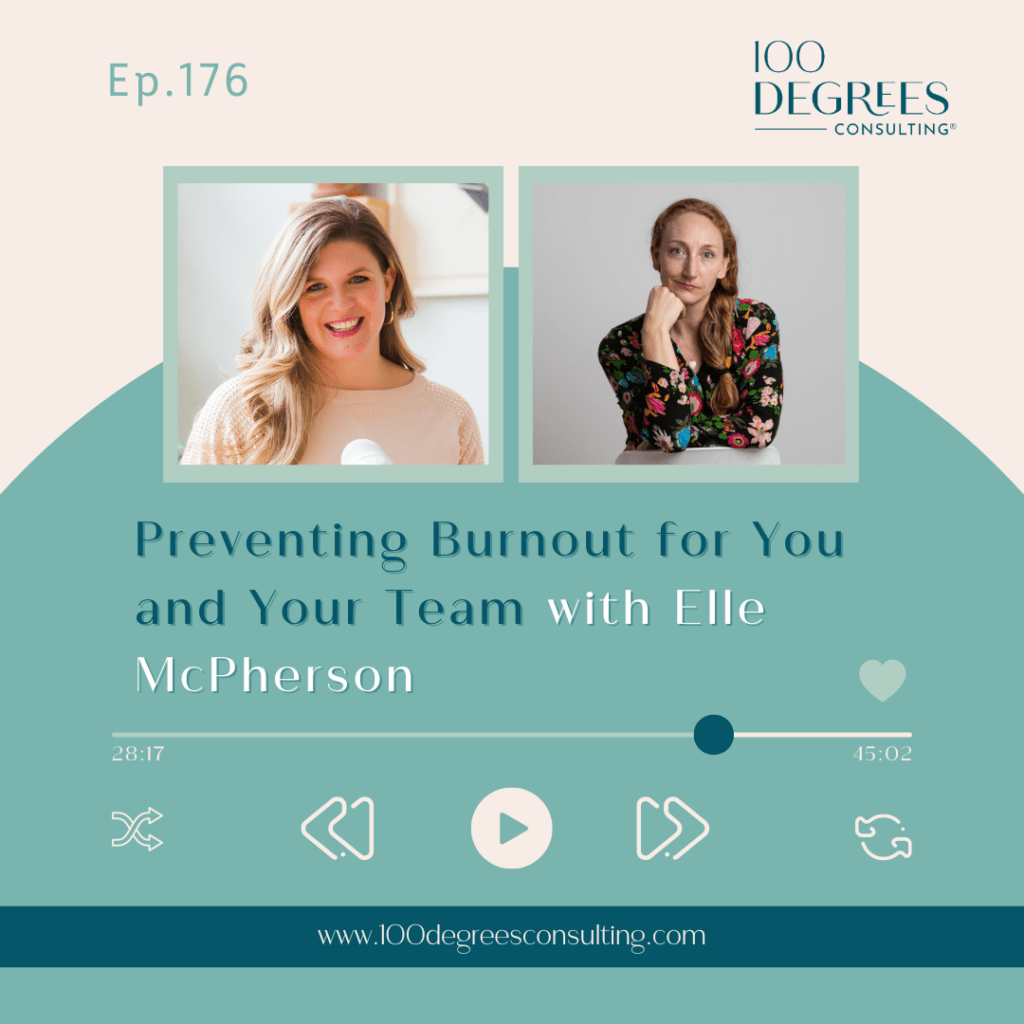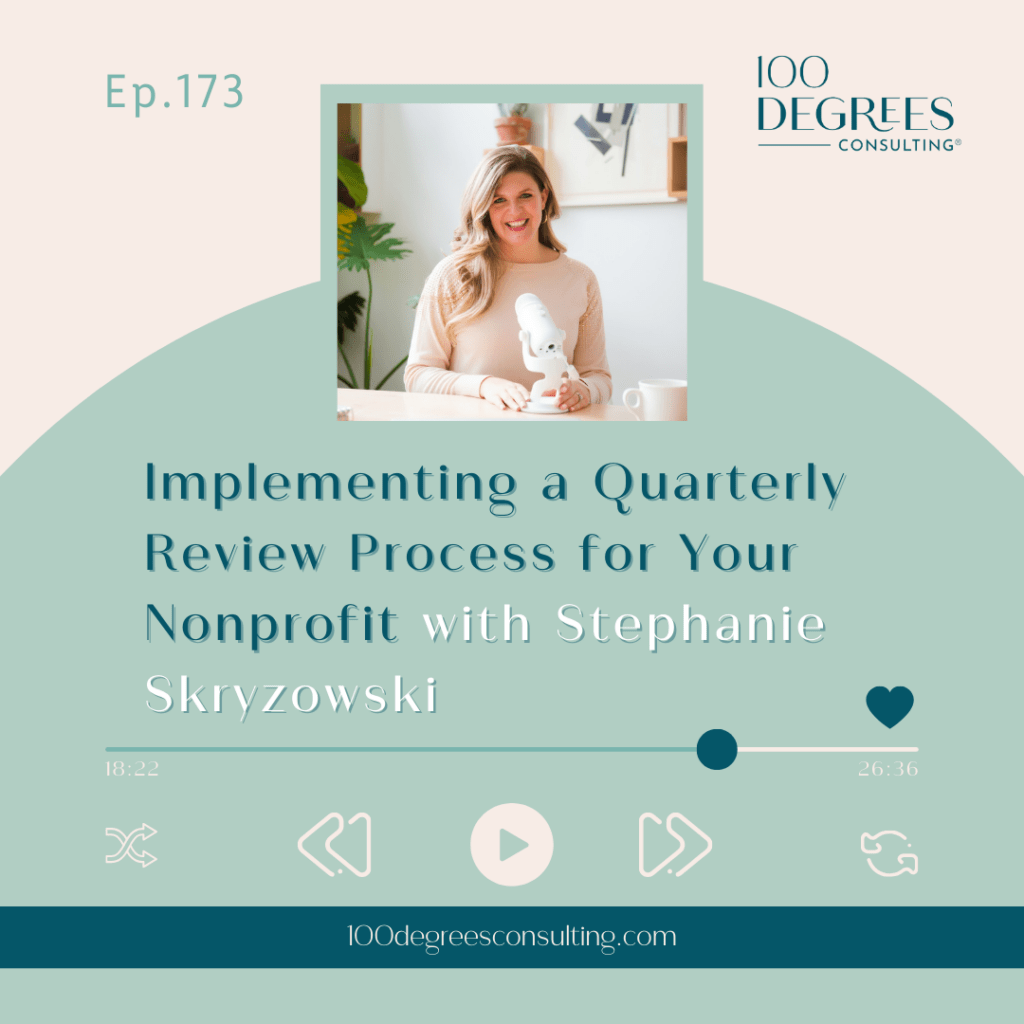Episode 76: People, Pay, and Profit with Candice Elliot
Transcript Episode 76
Stephanie Skryzowski: Welcome to the 100 degrees of entrepreneurship podcast. The show for purpose driven entrepreneurs who wanna get inspired to step outside of your comfort zone, expand it to your purpose and grow your business in a big way.
I’m your host, Stephanie Skryzowski, a globetrotting CFO, whose mission is to empower leaders to better understand their numbers, to grow their impact and their income. Let’s dive in.
Hey, everybody. Welcome back to 100 degrees of entrepreneurship. I’m Stephanie and I have a good episode for you today. I am talking to my new friend, Candice Elliot. Candice is an HR consultant, and oftentimes I feel like finance HR, and legal. We all get a bad rep.
You know, it’s super important for your business to have your finance, your HR, and your legal docs in a row. But it doesn’t really feel that fun or exciting. And you know what, we try and make it fun and exciting. I think this episode is gonna be really useful for you in thinking about some of the foundational HR things that you need to have in your business so that you don’t get yourself in trouble later.
And not only to avoid issues, but also to make sure that you have really amazing people on the team that want to stay with you. I think that’s what we all want, right. We know that hiring people is part of what we need to grow our businesses and you wanna have great people and you wanna have ’em stay a long time.
And so we talk a lot about several different things that you can do to make sure that you get great people on the team and that you get them sticking around. So here is about Candice. So Candice Elliott helps impact driven leaders grow their team with values aligned HR best practices.
Her zone of genius is with organizations growing from 10 to over 20 employees. This is the time when the organization has the best chance of developing foundational practices to increase diversity, equality, and a sense of wellbeing for all.
And just a little side note here, that is exactly where my business is. So you will hear me sharing some things about how my business is growing and the things that we’ve done internally. And just getting a little bit of coaching from Candice along the way. So back to Candice, her background is in HR.
She has a master’s in HR from Penn state, the senior professional certification in California, and has worked in the field for more than 10 years. During the pandemic, she supported the small businesses and nonprofit community by giving hundreds of hours of assistance to help meet the challenges of the changing world of work.
She’s a mom. And when she’s not helping support growing organizations, you’ll find her adventuring in her home of Santa Cruz, California. So again, if you think HR is gonna be boring, listen, because it’s not. I think this is a great episode for you and let’s dive in to chat with Candice.
Hey everybody. Welcome back to 100 degrees of entrepreneurship. I am really excited to be here with you today with my guest, Candice Elliot, Candice. Welcome.
Candice Elliot: Thank you so much for having me, Stephanie. I’m so excited to be here.
Stephanie Skryzowski: Yay. Well, we are talking about a topic that is one of those super important topics in your business that maybe it’s not some people’s favorite topic. Kind of like finance, but I have a feeling that you make it interesting and fun and very useful. And we are talking about HR today.
So tell us a little bit about your business and what you do.
Candice Elliot: Yeah. So my business is called Fortress and Flourish, and I am a human resources strategist. I work with impact driven entrepreneurs and nonprofit leaders to help them grow their teams and to keep those teams. So I have a few different types of programs that I do with folks. One of them is establishing HR foundations.
I find that when you get up to about 10 employees or when you switch to that zone of 20 or more people, then some cracks get to show. And so that’s a good time to do some good foundational work in human resources. And then the other big type of work that I do is around pay transparency and creating transparent and equitable systems of pay.
So I started my business in 201. And my route to becoming a business owner was pretty circuitous, like it is for, I think many of us. I did my undergraduate degree in anthropology and philosophy. So I got a very wonderful and deep understanding I think of the ways that cultures are different from one another. And how we all have many ways of doing things and through living in countries mainly in the middle east.
Then coming back to the United States, I could just see that. Although the ways that we live in our cultures are kind of different or vastly different in some ways. The core values that we have around family and treating people well and having work that’s meaningful are really the same, I think, around the world.
So I was doing archeology actually in the middle east, and I was going to go back to school and do a master’s in archeology. And I decided to take some time away from school. And I taught English as a second language for a number of years. I’ve met quite a few teachers who become entrepreneurs and managers.
I think there are a lot of similar skill sets there. And then I started my first company when I was 23 in Florida and we did bus tours for the 55 and over communities, the snowbirds in Florida. We took them to key west and Savannah and New Orleans and all these different places.
And I ran the business side of things and my business partner was on tours and doing more of the customer focused performance aspects. He was really great at that. And then we decided to close our business when I moved back home to California.
And at that time I decided to focus my education on human resources, because I really liked the combination in HR of culture and training and development, and also just building and maintaining relationships with people. I loved that. So I did Penn state’s online program in human resources and employment relations.
And at the same time, I ran HR for a restaurant group that’s based here in Santa Cruz. It’s a farm to table restaurant group, and we had more than 120 employees. And we hired about a hundred people a year and I did most of that hiring.
So I got a chance to really learn the ins and outs of the HR role through that crucible. And a few years ago, decided to go out on my own to be able to help other entrepreneurs with the same type of work. So lots of twists and turns in there.
Stephanie Skryzowski: Yeah. Well, I love that. And like you said, that is the case for so many of us, like we did not start out doing exactly what we’re doing now. And there have been like lots of twists and turns in the journey. At any point along the way, like, were you, was it scary?
Did you feel like, sort of outside of your comfort zone as you were pursuing that next new thing? Or did it all sort of feel like a, just natural progression from one thing to the next?
Candice Elliot: Oh, yeah. I had a lot of moments of fear and thoughts about like I’m an imposter, cause I’m doing this. Or like how do I even begin to begin something like this? I think there’s a particular moment when I started Fortress and Flourish where I was working for, they’re called The Glass Jar Restaurant group.
Zach and Kendra, the owners and we’ve known each other for years now. And I still do some work for them. And it just felt like I was going to betray them if I left. Like if I gave all of these responsibilities to someone else, it would be like this huge betrayal of their trust.
And how could I do that to these people who had supported me through my growth in this particular part of this field that I love working in. I actually decided to take a week away from working in order to process everything. And I went to a small town in Northern California that’s called Mendocino and there’s an art center there and I did a workshop.
And I’m a ceramic artist and they do, what’s called wood firing at the Mendocino art center. It’s a really fun process that goes on for a week and you’re literally chopping wood and putting it into this kiln. And all of your work is in there, and the work, when it comes out is really beautiful because you can’t quite tell what it will actually look like.
It’s how ash falls on the work and the atmosphere of the kiln and all of these different things that create these beautiful pieces. So over the course of this week, I was doing that workshop and then also thinking about what it would look like to be out on my own and how I would make that transition.
And one of the books that helped me was called I think it was Heart Navigation. One of the tools in that book is to write out all of your fears. And so I literally wrote out probably 20 things that I was afraid of. Like I’m not gonna be able to fix my car if it’s broken, like my community isn’t gonna support this work, they don’t want it.
All the things. And then I was able to, through that writing process, detach myself from those feelings and to look at them objectively and just say, okay. You know, I can probably deal with these things. One by one, sort of teasing myself out of being entwined with these fears and then moving forward. And it was two or three months after I did that process to when I actually left The Glass Jar Restaurant group.
And they were my first client in the new year of 2019.
Stephanie Skryzowski: Awesome. I love that. That’s really cool that you could go on this like creative retreat and also dream about your business and your career and what’s next. I love that combination. I do lots of retreats as well, personal retreats, but I’ve never done anything creative like that.
That sounds really interesting. So you’re a very creative person. I feel like we don’t think about HR as being very creative. Seems like it’s more compliance driven. Do you find little pockets of creativity in the work that you do now?
Candice Elliot: Definitely. So the work that I do is mainly creative. That’s why I transitioned from the responsibilities of HR administration into this kind of a unique role that I got to create for myself. Because I now get to work with entrepreneurs, business owners, nonprofit leaders. I have a big heart for nonprofit.
Most of my clients are nonprofit leaders and we create their HR systems. So oftentimes folks will come to me with some kind of an issue that’s happening. You know, maybe they hired two people at the same time that both didn’t end up being the right fit.
And so then they’re seeing different kinds of things with their hiring process and then, oh, wait, annual reviews. Maybe that should be a thing. And the things that work for 10 people or up to 10 people don’t tend to work once you get past that number or once you start growing your organization past that first core team because you just are widening your circle.
As you widen your circle, you come in contact with more people. And as much as you want to vet every single person, as much as you can, before they come into the organization, as you have more and more people, it helps to have systems in place for them.
Because they start to ask things like, oh, I took on all these responsibilities, but they’re not actually in my job description. So does my job description actually fit my job or should I be getting paid more? And so if there aren’t good systems in place, it can lead to conflict and miscommunication.
But when there are good systems in place, then it can help to attract people to you and keep people around and help with those clear lines of communication. But I love, I am a creator kind of to my detriment.
I will work and work and work not only on things for my clients, but also on my own business and there’s a point where I need to tell myself, okay, just set this aside now. And yeah, you don’t have to rework that sales page 20,000 times.
Stephanie Skryzowski: Exactly, exactly. I know. And I think that’s an important message for anybody listening, who looks at HR as this big, scary thing that’s annoying you have to deal within your business. Like it really doesn’t have to be that way. And it can be this sort of creative process it can lead to.
Having the right people on your team and keeping them on your team for a long time and really being able to make the impact that you wanna have in your business. And so I always try to flip this sort of flip the script on finance as well.
Like, no, this is not just something that you have to do because you have to do it. There’s some really powerful information that can inspire you and help you to grow as a business and as a leader. And so I love that you’re doing the same thing with HR. I think that’s super important.
I feel like I’ve talked to a few lawyers on the podcast as well. And so it’s like the three of us finance, HR, and legal. We’re like the people that keep things running and keep everything going smoothly, but nobody ever wants to talk to us.
Candice Elliot: Yeah, and they all kind of get intertwined with each other. You know, like HR and finance and HR and law. That happens a lot where I refer people out to an attorney because there are things that are in my wheel house. And then there are things that really, you need an attorney for.
Stephanie Skryzowski: Yeah. I’ve definitely seen that as well, yeah. That a lot of times HR people, you need to talk to your lawyer about that. What kind of things do you see? Like that’s the kind of thing where maybe you get asked the question, but you’re like, no, you need to talk to your lawyer.
Candice Elliot: Yeah. Usually when someone brings a termination to me, maybe it’s their first time doing a termination, or they’re concerned about this termination that’s coming up, like they’re ending employment with someone.
And so I can walk someone through the process of these are the best practices in going about that termination. But then I also ask, is there anything different about this person’s employment with your organization?
And sometimes the answer to that question will lead me to referring them over to an attorney because I am not one, but I know things that need to go there. And a lot of them have to do with wrongful termination claims and claims of discrimination.
Stephanie Skryzowski: Yeah, that’s a good thing to remember anybody who’s listening. If it has anything to do with, if there’s anything different about their employment, make sure you talk to a lawyer.
Candice Elliot: Yeah, definitely. And I love your flipping the script on finance because that is definitely how I feel about HR. I think that there is a way to do HR differently. Where it is not this four letter word that when you say it, it’s like, oh, HR, we gotta do the, like all these things.
But really to have it be a set of systems and practices that bring your organization better equality, better candidates. Yeah, just more quality within the organization, within the experiences of people in the organization.
It can be just a wonderful tool for that and it doesn’t have to be just a bunch of paperwork that has to be filed. Although there is that side of it too and you can hire that job out.
Stephanie Skryzowski: Yes, yeah. I feel like HR, like finance is a great thing to think about outsourcing in your business because likely as the CEO or as the person owning the business, you’re probably not an expert in HR. I mean, you happen to be, Candice, but most people are not.
So it’s a great thing to hire out. And you mentioned that you look at the, sort of the foundations of a business when you start working with somebody, what are some of those HR foundations that you’re looking at, or that you like to see organizations have in place as they’re starting out or in those early stages of growing?
Candice Elliot: Yeah. So when I start working with people, usually do a discovery call and just talk about what’s going on in their organization. One of the first things that I ask about is their employee handbook. If there is one or not. And then if there is one, how long it’s been since it’s been updated.
There are best practices in employee handbooks that tend to change every, sometimes it’s two to three years and sometimes it’s every year. Depending on what’s happening with different legislatures and laws and things that are passed in each of the different states.
I work in all of the states in the US and I also work with US corporations that have international employees. Because California is one of the most complex HR parts of the world. It’s happened that I’ve been able to acquire kind of all of the knowledge that you need to do HR in the United States and then also in some international countries.
But the handbook is one. Another thing is when there’s an employee issue. And I do 30 minute or an hour long strategy sessions with folks around those issues when they come up. Sometimes an organization will want to do a policy.
Maybe they’re looking at how time off is working or how leaves of absence are working in their organization, or they have a pregnant employee and they need to do a medical leave of absence and it’s their first one. So often I get the it’s my first time doing this how do I do this questions.
Which I love helping to educate people on how to do these things with best practices and in order to avoid claims of discrimination and wrongful termination through those best practices. So those are some of the things.
Stephanie Skryzowski: Yeah, that’s great. And I feel like as a business owner, who’s in the early stages of hiring their first few employees, you don’t think about needing an employee handbook. Maybe you think back to your first corporate job where you get this big employee handbook that’s like a bunch of whatever that you probably don’t ever look at past your first week.
But it is really important. Like you said, and I think it clarify as your position as a company and your policy so that where there are questions in the future, and there will be, everything is already documented and you’re not making things up on the spot, cause that’s where issues like discrimination come into play.
Not intentionally, you’re not intend, well, you’re probably not intending on any type of discrimination, but if you don’t have a written policy, it can really easily go that direction. So I think that’s super important. And honestly, even in my business, that’s something that we just did.
We’re at 15 employees right now. We just did this like within the last two years. And so we didn’t have it in the beginning and thank God, we didn’t have any issues, but it’s something that I probably would have done sooner if I had really known about the importance of that.
So I think that’s huge for anybody that has employees. And I was gonna say too, when you were talking about really like organizing and documenting and having processes for HR is really gonna lead you to acquire better people, better talent on your team.
Again, we spent a lot of time in the last two years, really like streamlining our recruiting an onboarding process. And we have received so many compliments by both people we’ve hired and people we haven’t hired. Like, wow, your like hiring process is so good.
It’s so smooth. It’s so clear. And I’m like, isn’t that the first impression that you wanna give to somebody that’s gonna come work for you? So yeah, I love that you’re helping clients with that too, because I do think that that is. Yeah, it’s just overlooked.
I think we’re all just like trying to get the work done and don’t think about those kinds of things. But it really makes a big impact not only on you, but on your clients and the client’s experience as well and just everything. So I love that.
COMMERCIAL:
Hey friends, are you feeling stuck with what to do next to manage the money in your business? Maybe you’ve logged in to QuickBooks once or twice, but got instantly overwhelmed, maybe you started to set revenue goals, but don’t know where to go from here. Maybe you simply know that managing your numbers is the right thing to do, but you don’t know what that actually means.
I’ve got you covered. I have a brand new 10 step checklist to manage your business like a CFO without making it your full-time job. Head over to 100degreesconsulting.com/checklist to get the free checklist.
One thing I wanna talk about is pay transparency. This is something that is one of your passions, I think. So I would love for you to tell us a little bit about what do you mean exactly by pay transparency? If somebody’s never really heard that term before, what does that mean? And what kind of work are you doing around transparency?
Candice Elliot: Yeah. So this is another one that I think folks tend to not think about until later on. And if you start thinking about transparent systems of pay earlier. And as you’re creating the ways that you’re paying people earlier on, it can have wonderful effects as you move forward and start hiring more people.
Pay transparency exists in a spectrum of zero transparency where nobody knows what they’re gonna be paid ever. And it’s just a big surprise all the time. It’s not a part of the hiring process.
It’s just you know, maybe you don’t even get a job offer, you just start working and then the person is paying you an amount and it’s totally at their discretion. And you have no say in it. So that’s one end of the spectrum. The other end of the spectrum is being fully transparent about pay.
So having pay posted in your job ads. Having pay as a part of the conversations that are happening through the hiring process. Someone knowing what they’re being paid when they are hired. Having milestones along the way where there will be check-ins about pay and a good idea of what they think they’re going to make as they move forward with the organization.
Building a transparent system of pay can look a lot of different ways. And I typically do this with nonprofit organizations. Although for profit organizations have these kinds of systems as well. But we look at all of the jobs in the organization.
What the responsibilities of those jobs are, and what the organization is paying each of those positions. And the first look is just internal. Like does all of this make sense? Are people with more responsibilities, getting paid more? Are people who are still learning getting paid a little bit less than those people?
That’s generally how a hierarchy of pay works in an organization. More responsibilities equals more pay. But sometimes you’ll have outliers when you first look at it. Where one position is paid significantly higher than maybe other people in the same realm of responsibility.
And so that is where we kind of earmark and we come back later. Because those are the kinds of things that we wanna create something that will apply equally to all of the positions. And we don’t wanna have outliers because those are the kinds of things that eventually can become problems.
Like why did this employee, why was this employee paid twice as much as I was while I was in the organization? If there’s no real documented reason for that, that can become an issue down the line. So there’s a protective aspect of transparent pay, and then there’s a motivational aspect to it as well.
So the next piece is to go out into the external environment and to look at what other organizations are paying. And so I’ll look for organizations that are similar to the one that I’m doing to pay analysis for. Then I’ll look at ones that are competitors because they may not be the same.
You know, maybe I’m hiring for an architecture position or a planning position. And so I’m not just gonna look at the other architecture firms. But I’m also gonna look at the cities and maybe there’s some nonprofits that are also doing similar work. Like habitat for humanity or different places like this.
So I look at this kind of broad spectrum. I also try to look at a dispersed geographic area. So I’ll look locally where the organization is located, but then also in other places in the state. If the jobs can be hired anywhere in the state or anywhere in the country. The cost of living in different places all across the US can vary widely.
And so the tool that I use to create similarities between the different areas is living wage. So the MIT puts together every April, I think is when it’s released a study of what the living wage is in every county in the United States. And so that includes basic expenses.
Like, you’re not having fancy vacations if you have this wage but you’re able to pay for your housing. You have rent or your mortgage, medical expenses, food, and all these, car expenses, these types of things. And so it’s a good coefficient for looking at what pay should be in different regions based off of what this living wage number is.
And so then we go into creating pay bands. So we separate all of the jobs into different categories and we have pay that is assigned to each of those categories. And then the pay increases generally year over year. Those increases are 3-5% or 3-7%. And then there’s like a hundred more details that I could go into about this too.
Stephanie Skryzowski: Yeah. This is so interesting. So it all starts with disclosing the salary or putting it on the job description. Are there any instances where that’s not a good idea? Or like, wait, you’re like post it with the job description period?
Candice Elliot: I generally recommend unless there’s some wild reason not to, which I haven’t really had that come across my desk ever. I recommend posting the pay in the job description or including it in your promotional materials about the position, or if you’re sending it out in newsletters, putting it on Instagram, all these different places.
Adding the pay because then people who are looking for different pay can self select out and people who are looking for that pay can select in. So I think it’s a really important thing to post. And then in the interview process to check in, you know, this is the pay that we’re thinking about, does that fit with what you need?
And the person can say no, or they can say yes, but. So giving people the opportunity to talk about it throughout their process is important.
Stephanie Skryzowski: I feel like if I were to think of any objections to doing that, it would be that you would be turning off certain people. Maybe there’s somebody that would be like once they talked to you, maybe they’d be willing to take a bit of a pay cut. But they’ve already self-selected them out because it seems too low for them or somebody who thinks that they see that salary, maybe that’s higher than what they have been paid before.
And so they are like, well, I don’t think I could do that job, but in fact they may be actually a really good fit. So have you found that like it deters people at all, it deters the right people at all? Or do you find that like, not really, it’s mostly just self-selecting in a good way.
Candice Elliot: So what I’ve found is that if you can be as accurate about the job ad, about what the job is, when you’re posting it, then you are more likely to find exactly the right fit for the job. It’s like when you’re trying to define your ideal client, right? You’re not defining a really general client.
You’re defining oftentimes a specific person or a person who has certain qualities. So you want that job ad to be like that for the person that you wanna hire. So starting with usually a description of the company or the organization and what you do and why that’s really impactful and awesome.
Then a bit of a description about the job is what I recommend having next, especially what the day to day looks like of the job. I find in that job summary piece often, it’s just like a repeat of what’s in the next section. And I think you’re losing a big opportunity there because I think when you get to that section, you should be able to see yourself in the job and see yourself wanting to do it.
You know, if it’s primarily remote or if it’s in person or what the work environment is like, how the mission vision of the organization works its way into your work. That’s a really great opportunity for that. And then having a list, general list of the duties. What is this person gonna be responsible for?
If its an annual focus or a monthly focus or a weekly focus or a daily focus. I think that can be a way to break it out and then to be specific about the pay so that people can recognize themselves or not recognize themselves in it. And if someone is deterred by pay being much higher, then that could lead to issues once you hire them.
The same with the pay being too low. So you want people to be able to see themselves in the pay that you’re listing. Maybe there’s a low end and a high end of that pay and you can negotiate within that range. But I have not found it to weed out the right people, but that it weeds out the wrong people.
Stephanie Skryzowski: Yeah, yeah, that makes sense. That makes sense. I know, I don’t know why is it like, it’s just, I don’t know. I feel like money has always especially pay salary is always just been so taboo to talk about. That it feels like as an employer, I’m like, I don’t know if I wanna put this out there. Like I understand.
Candice Elliot: I know it’s like a dirty secret, right.
Stephanie Skryzowski: Exactly.
Candice Elliot: Like you don’t wanna talk about. It makes people really uncomfortable. And instead of it being something that makes people uncomfortable, it can be a reason that people stay because it makes people feel safe and they can see, you know, they understand it.
And as much as people like exciting things and they like mystery, they don’t love that for the most part in pay in their jobs. Generally these systems once they’re implemented, or once you have transparency in pay and right, it’s a spectrum.
You don’t have to start all the way with every single bit of pay transparency. But once you start talking about pay, then there’s a better conversation that can happen. A conversation can happen. I think too, it’s tied to the profitability of the company.
And so a compensation system does not work if it is not affordable. So a lot of the issue about talking with people in your company about their pay has to do with really your profitability as an organization and how you’re allocating all of your funds and what investments you need to make, and the overhead that you have.
And so having a clear understanding of your profitability and how that fits into pay. So compensation is a piece of that is important too.
Stephanie Skryzowski: Yeah. I mean, you know, like I’m all about all things profitability and really understanding those numbers. And this is just such an interesting conversation because this is literally like work that my client success manager and I are doing in our business right now.
And we’ve gotten to the point where we do have pay bands for each of our three. Like we have three sort of levels of people. We have our bookkeepers and finance managers and CFOs, and there are pay bands for each of those. And everybody now fits into one of those pay bands. So we feel like there’s a lot of clarity around that.
Whereas before I was just like, I don’t know how much I should pay them. Does this amount sound right? But now, like everything is really nice and tidy there. And so that’s good.
But now we’re working on, like you were saying that really understanding the profitability of the business to make sure that we can pay people what we need to pay people to retain the talent that we want to have in the business. And it’s really all tied together.
And one thing that we’re exploring right now that I know you have some thoughts around is our offers and our pricing of our services to make sure that like our pricing is aligned with the value that we’re providing. I know that what we do is hugely valuable to all of our clients.
And I know that the people on our team are top notch, like so good. And so there were a lot of situations where some of our clients had sort of legacy pricing where their price hadn’t increased in three years. We are giving them way more, like way more people, way more just services, quality value than before.
So do you have any thoughts on that? Cause it’s something that’s just like very timely for us is like to be able to afford to pay all these people and maintain our profitability. Really having to re-look at the pricing of our services.
Candice Elliot: Yes. So I just went through this process. So in Santa Cruz county, where I live. Last year, the living wage was around $21 an hour. The year before that it was around 18 and now it is close to 28.
So our living wage has increased by like, it’s just an insane, exponential increase that happened in this past year related to locally our cost of housing. I think it’s like $3,200 for a studio here. It’s crazy. A studio apartment. Yeah, so we’re dealing with some really intense housing disparity issues, which result in homelessness.
And it gets all into many things that I could also talk for hours about. But so I looked at, I needed to increase the pay of my staff because I was paying them relative to last year. And so I needed to make increases to their pay of a significant amount.
So I needed to look at my offers and what I was charging for those offers to have more alignment between what I was putting out into the world and the value that’s there and the service that I’m providing for my clients. And then also the ability to support my staff in the way that I want them to be supported so that they can thrive.
Most of them live here, so thrive living here. Because the most difficult part of that pay situation is when people make between the minimum wage and the living wage. Because they don’t qualify for any benefits from the state in that zone or state or federal government.
And so that is where people are most likely to actually fall back into poverty. Is because they don’t have enough to support themselves. And so then there are all of these issues that happen, like huge amounts of debt and unsafe living conditions and all of these other things that happen.
So it was really a value of mine to be able to pay people more so that they can afford to live here. And what I found was that it was a lot of work on the back end of really being clear about what I wanted to bring forward as a service and what I needed to let go of because it no longer fit.
Then just being really clear about with all of my clients and my former clients about the changes that were coming up and when they were gonna take effect and how I was gonna be able to serve them moving forward. And communicating it in a way where I’m really better able to help them because I’m making these changes.
I realized that because of the way my pricing was happening previously, I wasn’t actually able to give the quality of service that I want to give to my clients because I was spread too thin. And because I wasn’t able to hire out key pieces. And so because I made these changes to the offers and to the pricing structures, everybody’s happier.
I think it’s working well. There are only a couple of people where they felt like the pricing, the new pricing was out of the realm of possibility for them. But everyone else felt that it was fine.
So that was how I went about it. I did a course recently with Erika, The Sell it, Sister is her podcast. And that also really helped with this whole thing. I feel like you have to bring in experts to help with things that you don’t know how to do yourself.
Stephanie Skryzowski: Yes. Yeah, absolutely. So if somebody was at the point where they’re listening to you and they’re like, okay, I gotta take a look at this in my business. I’m maybe I’m not like quite at the point where I’m ready to hire somebody, but I need to. I really wanna take a look at this.
How would you suggest they go ahead and get started? Is it that MIT living wage calculator website, would that be a good place for a business owner to make sure that the wages that they’re paying are a living wage?
Candice Elliot: Yeah, I think that is a good one. MIT is living wage calculator. And then also looking on local job boards to see what other similar organizations are paying for the job.
Stephanie Skryzowski: And that would be assuming that those other companies are posting their salaries on the job description.
Candice Elliot: Yeah, and you’re seeing it more and more often now. So there is more data out there than there used to be. Yeah. So that is yes. Assuming that they are posting as well.
Stephanie Skryzowski: Right, right, exactly.
Candice Elliot: And then if you are doing this and you have a question about your position and whether you think it fits or not, you can always send that over to me. I’m happy to kind of, because I have a brain now that has all of this data that’s in it.
And I can tell you if it seems like it fits or doesn’t fit and then point you at some more resources. If that is, would be helpful.
Stephanie Skryzowski: Yeah, yeah. That’s super helpful. Well, I advocate a lot for financial transparency and encouraging business owners to share at least part of their financial picture with their team so that their team is more engaged.
And so I love the idea of salary and pay transparency because I just think that it, all the benefits that you shared and also just like, yeah. I don’t know, I just feel like when people know more, they’re more bought in and they’re more engaged and I think that’s what we want.
We want an engaged team. And so I love that. So I like to ask a couple questions of business owners at the end of all of our episodes. This has been like so helpful. First of all, I think there’s gonna be just like a lot of takeaways from people.
And I know I’m gonna go over and check. Actually, maybe I’ll have our operations manager go check out the MIT living wage calculator and make sure we’re good to go on everybody’s salaries cause we have remote employees all around the country.
Candice Elliot: It’s such a good tool for that. I was so happy when I found it.
Stephanie Skryzowski: It’s interesting that I know. I just popped over there really quickly while we were talking and it’s like every single county. So you gotta figure out which counties your employees live in, but that’s super helpful.
Yeah, love it. I like to ask how do you manage the numbers in your business. You don’t have to share any like actual numbers, but like how do you manage your finances, your numbers? Do you have any routines or specific numbers that you’re looking at? I always like to hear from people cause everybody does things a little different.
Candice Elliot: Yeah, yeah. I actually decided this year would be my year for figuring out what’s happening with money. Yeah, it’s great. I had my son last year, he’s gonna turn one in a couple of weeks. And so I took-
Stephanie Skryzowski: Congrats.
Candice Elliot: Thank you. So I took some time away from working three months after he was born. And so right after I came back, I was just putting everything out there. Like whoever needs HR things come my way. And now it’s become more organized as I’ve had more time to wrap my head back around the business and move it into a phase two. It’s a toddler now, it’s four.
So things are changing. But on the number side my bookkeeper is amazing. And she handles all of my accounts payable and receivable and all of that side of things. I don’t do that anymore.
That was one of the big changes that happened after my son was born. I was like, I don’t wanna be in QuickBooks all the time.
Stephanie Skryzowski: Yes, amazing.
Candice Elliot: Yeah. On a monthly basis, I look at the profitability of the organization and make sure that I’m able to pay all of my staff. And if I don’t have enough money for everything, I pay my staff and my bills first. And then I wait on paying myself which is I think a lot of business owners do that.
It has not happened for me many times that I have had to do that. Just like a month or two here and there. Yeah. I have learned a lot about like saving this year. So, The Psychology of Money was a book that I read recently. That was really interesting.
Just about the way that you grew up and the things that you learned about money in your life aren’t necessarily the things that are gonna work or work well. Yeah. And then there was another one that’s called Get Good with Money, and the Budgetnista wrote it.
And this is about yeah, personal finance. So I project out what is happening. Most of my contracts happen over the course of three months. So I know deposit amounts and then what the payments are throughout the course of the project. So I project out what that is.
Something with something called the cash flow tool. My friends own this organization that’s called the Kenza Collective. And they are a fractional CEO and CFO. And so the cash flow projection tool is something that I got from them.
So you input when your payments are coming in and what your expenses are and when they’re going out and then you can see how you’re doing there.
Stephanie Skryzowski: Awesome.
Candice Elliot: And yeah, so that’s generally what I do about money. I feel like it’s a big, a huge learning process. I did not learn a lot about money growing up, I had to figure it all out on my own. And so for me, I always come from a place of like, there will never be enough with money which comes with its own challenges.
And then on the other side of that, sometimes I’m like, oh, there’s all the money in the world. It’s fine, let’s spend it all, it’s great. But I think one of the best things to do with money that comes in through a company is to reinvest it.
So reinvest it. I reinvest into people and then into projects and classes that are gonna move the needle forward where I wanna go.
Stephanie Skryzowski: Oh, I love it. That’s so good. And you really hit on a lot of the things that we do and we recommend, so I’m like, well done.
Candice Elliot: Okay. That’s alignment.
Stephanie Skryzowski: Exactly, exactly. All right. Well, before we wrap up, tell our listeners where they can find you, learn about everything that you do. And if they’re like, oh my goodness, I absolutely need some HR support in my life right now. Yeah. Where do they find you? How can they get in touch?
Candice Elliot: Yeah, there’s a few places. So I am definitely on Instagram all the time. I love hanging out there. My website, you can go there and sign up for my newsletter. I send out a monthly newsletter that has all kinds of HR tips and tricks and current events and interpretations of things.
And then also you can, if you just wanna get to know each other, and you’re not sure if you need to do HR work or you’re just interested in talking about some HR things, we can have a discovery call that is totally complimentary.
I’m happy to talk with anyone about HR. And if you have a specific issue that’s going on that you’re really looking for some advice on, we could do a strategy session. So I would love to get to know you, if you think like this might be something that you wanna work on.
Stephanie Skryzowski: Awesome. Thank you so much. I know that a ton of our clients often come to us with HR questions or HR issues, and we’re always looking to point them in the direction of amazing people like you. So this is awesome.
Thank you so much for sharing all of your wisdom and hopefully everybody’s encouraged to be more transparent about your pay. You’re gonna get better people on board. So thank you so much, Candice for being here.
Candice Elliot: Thank you so much for having me.
Stephanie Skryzowski: Thanks for listening to the 100 degrees of entrepreneurship podcast. To access our show notes and bonus content, visit 100degreesconsulting.com/podcast. Make sure to snap a screenshot on your phone of this episode and tag me on Instagram, @stephanie.skry and I’ll be sure to share. Thanks for being here, friends, and I’ll see you next time.




















